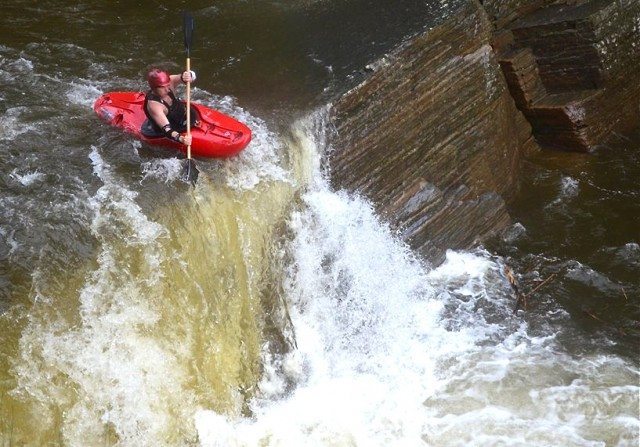
Stohlquist Descent PFD
Buoyancy: 16.5 lbs. (at sea level)
Reviewer Info
- Height: 6’2”
- Weight: 200 lbs
- Waist: 35”
- Chest: 43.5”
Tested Size: L/XL
Days tested: Over 300
Locations: Throughout the continental U.S., Chile, Argentina, Quebec
The Descent is Stohlquist’s kayak-specific, high-end rescue PFD. It’s billed as a low profile, feature-rich, durable vest for all types of kayaking, and it has the quick-release harness and full-strength shoulder straps that characterize a rescue vest.
It is worth noting that the USCG classifies the Descent as a Type III PFD (a “flotation aid”), and not as a Type V “special use vest,” the classification of most whitewater rescue PFDs. Stohlquist claims the Descent has 16.5 lbs. of buoyancy at sea level.

Fit
First off, I have to say that I really appreciated the Descent’s side-zip entry. As someone with chronic shoulder problems and a past dislocation (not uncommon for a lot of paddlers), the side-zip eliminates the need of having to inchworm in and out of a slip-on vest like the Astral Green Jacket.
The Descent is fairly blocky, and for someone of my height (6’2”) it sits a little high on my chest. The shoulder straps have elastic tensioners, but these aren’t adjustable, so wherever the Descent falls on your torso is where it will stay. This is different than most other rescue vests on the market that feature either adjustable shoulder straps or adjustable torso length.
The front and back foam panels are contoured to wrap around your torso, but they’re relatively thick and don’t move well with your chest and stomach while paddling. I found the Descent to be less comfortable than other high-end rescue vests I’ve worn, and while is costs less than some other vests in this category (the Astral Green Jacket costs $50 more, for example), for $189, it seems like the Descent should have a more performance-oriented fit.
The Descent has a small “belly” strap at the bottom and an angled strap that starts above the breast and wraps down and around the side of the torso on each side. The straps are well laid out—it’s easy to adjust side and chest strap tension while wearing the vest, and I never had issues adjusting my vest over different layers.
The breast straps did have the unfortunate side effect of causing extremely uncomfortable nipple chafe when I paddled shirtless, however. And while the Descent didn’t ride up when I tightened the belly strap, that wasn’t the case when the strap was loose. And unfortunately, the strap was pretty uncomfortable when it was cinched down.
On each side of the PFD beneath the adjustment straps, there’s a ~5-inch wide piece of neoprene that connects the front and back panels. This provides some impact protection, but it also makes the Descent warmer than I would like when paddling in the summer.
I found the flotation to be sufficient when I was swimming to keep me floating high enough out of the water to breathe and assess my situation. And when push came to shove, this vest did its job admirably.
During the one truly scary swim I had while wearing this vest—a vicious beating in a highly aerated uniform ledge hole that resulted in shoes (the lace-up variety) being torn off my feet and water forced into my mouth—the Descent stayed on and more or less in place, keeping my head above water as I was flushed deep to resurface ~30 feet downstream.

Sizing
The L/XL Descent fits like most other L/XL kayak-specific vests I’ve paddled. If you need some guidance, the chest measurement ranges that Stohlquist provides are a pretty accurate way to determine what size is appropriate for you.
Keep in mind that if you’re thinking about which size Descent to buy, you should know where the vest will fall on your torso. If you’re tall like me, it will likely sit high on your chest, and where it sits can determine how comfortable the vest will be for you.
The discomfort I experienced (with the belly strap, nipple chaffe, and awkwardly high vest), might be due in part to my height. So if you’re looking at the Descent, I’d definitely recommend trying it on first.
NEXT PAGE: Features

